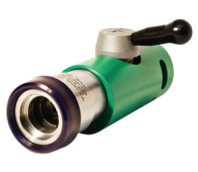The drive to find alternative energy sources for vehicles has seen a dramatic rise during the last decade. From electric to hydrogen powered passenger and commercial vehicles, the world has more options than ever. But with an increase in choices come questions and uncertainty. How do I fuel my vehicle? Is it difficult? Is it safe?
 Manufacturers of hydrogen fueling dispensers understand the trepidation that comes from experiencing something new. Because of this, hydrogen fuel dispensers feature a simple mechanism of operation but are manufactured to have a sturdy appearance and feel. The intent is to create a low-learning curve while implicitly assuring the consumer the product is of high-quality construction.
Manufacturers of hydrogen fueling dispensers understand the trepidation that comes from experiencing something new. Because of this, hydrogen fuel dispensers feature a simple mechanism of operation but are manufactured to have a sturdy appearance and feel. The intent is to create a low-learning curve while implicitly assuring the consumer the product is of high-quality construction.
The photo on the right is an example of a hydrogen nozzle. After pushing the front of the nozzle onto a vehicle's receptacle, the operator simply rotates the handle 180°. The rotation engages the jaws of the nozzle creating a secure connection with the receptacle. Hydrogen gas will only flow through the nozzle after a secure connection is made.
After the user has finished the fueling process, the operator must slowly rotate the handle 180° back toward the handle's original starting position. This action automatically stops the flow of hydrogen, vents the hydrogen trapped in the nozzle and releases the nozzle's jaws from the receptacle. The nozzle is returned to the dispensing unit and is ready for the next fueling occurrence.
As with any energy source, certain precautions must be taken to promote safe practices. And, as with traditional fuel dispensing systems, hydrogen-fueling stations utilize safeguards to minimize overall risk. An example of a safeguard is an in-line breakaway.
Every day, people rely on in-line breakaways to protect fueling stations and the environment during accidents (e.g. a vehicle driving from a fueling station with the nozzle still connected to the vehicle – known as a drive-away).
The in-line breakaway is installed on the hose that runs from the dispensing unit to the hydrogen nozzle. The position of the in-line breakaway creates two sections of hose. In the event of a drive-away, the breakaway separates, allowing the lower hose section and nozzle to safely “drive-away” with the vehicle.
The design of the in-line breakaway is to "break" or separate only when extreme forces are applied such as in the case of a "drive-away." This alleviates pull forces on the dispensing unit, allowing it to stay positioned on the fuel island. Additionally, the breakaway is designed with two check-valves, one in the breakaway (lower) housing and one in the stationary (upper) housing. This is designed to ensure hydrogen in the vehicle-side (lower) hose or dispenser-side (upper) hose does not escape. By keeping the dispensing unit intact and with the check-valve design of the breakaway, the possible release of fugitive emissions from fuel line rupture has been mitigated.
As more hydrogen fueling stations appear across the globe, people will become more comfortable and familiar with the technology. And one day, the world might become a place that could not imagine living without hydrogen and its benefits.
To learn more about OPW, contact your local OPW Sales Representative or OPW Distributor.